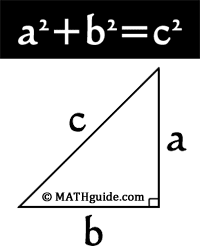Bonez,
Not quite. Here's the formula.

-----------------------------------------------------------------------
In the original wind example, c = 16. a & b are equal.
16 squared is 256. Because a = b, and (a squared) + (b squared = 256), both a and b will be the square root of 128 (half of 256)
11.3 * 11.3 = 127.69 - close enough. Actually 11 is close enough for me.
This equals the vectored wind effect. I still have to factor in the distance. Half of 160 = 80, which is the percentage effect of the wind, so I multiply 11.3 * .8 = 9 and a tad, representing the wind effect in yards.
--------------------------
That's the full calculation, but just understanding the idea, I come pretty close, just knowing (in this particular example with a = b, about 2/3 is the ratio that gets me close enough. Heh, doing the above with a 60 second time limit in multi, would be daunting. I suppose someone could come up with a chart that would include the scenarios where a doesn't = b, ie wind out of the 2:00 o'clock direction.
Hope this clarifies it.